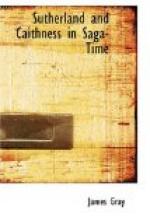assigns whomsoever, all Creich and much of Dornoch
parish up to the boundaries of Ross, and the date
of this grant was probably about 1211. The Mackays
were beginning to occupy the western parts of Strathnavern,
their title being probably their swords, and they held
their lands “manu forti,” their country
being a refuge for their Morayshire kinsmen, the MacHeths,
who were in constant rebellion. The eastern portion
of Strathnavern, and particularly the neighbourhood
of Loch Coire and Loch Naver, and all the Strathnaver
valley were probably insecurely held by members of
the Erlend and Moddan family after Harald Ungi’s
death at the battle of Clairdon in 1198; and Gunni,
probably a grandson of Sweyn Asleifarson, who had married
Ragnhild, Harald Ungi’s youngest sister, after
the death in the same battle of Lifolf Baldpate, her
first husband, became chief of the Moddan Clan there
and in Caithness. After 1200 Ragnhild had by Gunni
a son called Snaekoll Gunni’s son, who thus became,
on his father’s death, the chief representative
in Scotland, both of the Moddan family and of the
line of Jarls Erlend Thorfinnson, St. Magnus, and St.
Ragnvald, and of Eric Stagbrellir and of Earl and Jarl
Harald Ungi; and Snaekoll afterwards laid claim to
their possessions in Orkney, as the sole male representative
of this line. Gunni and Ragnhild must have held
the Strathnaver lands, and the Moddan family lands
in Caithness, formerly Earl Ottar’s estates,
till their deaths, and Snaekoll was their sole known
male heir. The Harald Ungi share of the Caithness
earldom lands, which
The Flatey Book and
Torfaeus
state that Jarl Ragnvald had held, does not appear
to have been granted to David, or to any successor
to the Caithness earldom of his line, or to any other
person at this time. Indeed, the line of Paul
were the last persons to whom such a grant would be
made.
It was, therefore, to a very much reduced territory
and earldom that David succeeded in 1206, as Earl
of Caithness. We hear almost nothing of him,
save that for the latter part of the eight years of
his rule,[1] more or less inefficient probably through
ill health, he shared the earldom and what had been
left to him of its lands with his younger brother
John. David died without issue in 1214[2] probably
soon after Hugo Freskyn, and David was succeeded by
his brother John in the jarldom of Orkney and in the
reduced earldom of Caithness as sole jarl and earl.
Immediately after David’s death, King William
the Lion, who had, in 1211, suppressed a rebellion
in Moray of the Thanes of Ross under Guthred son of
Donald Ban MacWilliam whom a few years later he captured
and beheaded,[3] came to Moray again; and, about the
1st of August 1214, King William demanded, and received[4]
Earl John’s daughter, whose name is not known,
as a hostage for her father’s loyalty, and a
guarantee of the peace then made, under which John
was probably recognised as earl and as entitled to
his reduced territory. His daughter may, at this




